To care for hydroponic plants, provide them with adequate water, nutrients, and light while maintaining proper pH levels and monitoring for pests or diseases. Growing hydroponic plants involves eliminating the need for soil by growing plants in a nutrient-rich solution instead.
This method allows for better control over plant growth and ensures optimized nutrient absorption. Whether you are a beginner or an experienced hydroponic gardener, it is crucial to follow specific care guidelines to ensure the health and productivity of your plants.
We will discuss the essential steps involved in caring for hydroponic plants, including water and nutrient management, lighting requirements, pH monitoring, and pest control. Follow these guidelines to cultivate thriving hydroponic plants.

Credit: thursd.com
Benefits Of Hydroponic Gardening
Hydroponic gardening offers numerous benefits for plant care, making it an increasingly popular choice for gardeners. One key advantage is the increased crop yield achievable through this method. By providing plants with ideal growing conditions, such as the right nutrients and water supply, hydroponic systems promote healthy growth and maximize yield.
Another advantage lies in the reduced water usage. Unlike traditional soil gardening, hydroponics uses a recirculating system that conserves water. By delivering water directly to the roots, plants can absorb it more efficiently, reducing the overall water consumption.
Year-round cultivation is also made possible through hydroponics. By controlling factors like temperature, light, and water, gardeners can create an optimal environment for plants to thrive throughout the year, regardless of external weather conditions.
Hydroponic gardening also facilitates better pest and disease control. Since the plants are grown in a controlled environment, it is easier to monitor and prevent infestations. This reduces the reliance on chemical pesticides, leading to healthier and more natural crops.
| Benefits of Hydroponic Gardening |
|---|
| Increased crop yield |
| Reduced water usage |
| Year-round cultivation |
| Pest and disease control |
How to Care for Hydroponic Plants: Step by Step Guide
Setting Up A Hydroponic System
Setting up a hydroponic system requires careful consideration to ensure the success of your plants. Choosing the right system is crucial, as different systems have different requirements and benefits. Take into account factors like space availability, budget, and personal preferences when selecting the system that suits your needs.
Next, it’s essential to select nutrient solutions that provide the necessary elements for your plants’ growth. These solutions can vary depending on the type of plants you are growing and their specific nutrient requirements.
In addition to nutrients, setting up grow lights is another crucial step in caring for hydroponic plants. These lights mimic the natural sunlight that plants need for photosynthesis and growth. Ensure that the lights you choose emit the right spectrum and intensity for optimal plant development.
To maintain a healthy hydroponic system, regularly monitor pH and nutrient levels. Fluctuations in these levels can negatively impact plant growth. Use a pH meter and nutrient testing kits to assess and adjust the levels as needed.
Watering And Nutrient Management
When caring for hydroponic plants, one of the most important aspects to consider is watering and nutrient management. Finding the right water source is essential to ensure optimal plant growth. It is recommended to use filtered or distilled water to avoid any contaminants that may affect the plants.
Additionally, properly mixing nutrient solutions is crucial for supplying the plants with the necessary nutrients. Follow the instructions on the nutrient package and ensure the solution is well-balanced and evenly distributed.
Monitoring and adjusting pH levels is another vital step. pH levels can impact nutrient uptake, so it is important to regularly check and adjust the pH levels of the nutrient solution to maintain an optimal range for the plants.
Finally, timing and frequency of watering are essential for hydroponic plant care. The plants should be watered regularly, but not excessively, to prevent overwatering and root rot. The frequency of watering can vary depending on the plant’s needs and the specific hydroponic system being used.
| Watering and Nutrient Management |
|---|
| – Finding the right water source |
| – Properly mixing nutrient solutions |
| – Monitoring and adjusting pH levels |
| – Timing and frequency of watering |
Controlling Temperature And Humidity
Controlling temperature and humidity is crucial when caring for hydroponic plants. Maintaining optimal temperature plays a significant role in ensuring the plants’ healthy growth. It is essential to keep the temperature within the recommended range, typically between 65 and 75 degrees Fahrenheit. Providing adequate ventilation and air circulation is also essential to prevent heat buildup and maintain a consistent temperature throughout the growing area.
Moreover, managing humidity levels is equally important. Humidity should be maintained at around 60-70% during the vegetative stage and slightly lower, around 40-50%, during the flowering stage. High humidity can lead to the growth of mold and mildew, while low humidity can cause plant stress. To control humidity levels, using dehumidifiers and humidifiers can be helpful.
By controlling temperature and humidity effectively, hydroponic growers can create an ideal environment for their plants’ growth, ensuring optimum health and productivity.
Preventing Pest And Disease Infestations
Preventing pest and disease infestations is crucial for the successful cultivation of hydroponic plants. Maintaining a sterile growing environment is the first step towards achieving this. Regular monitoring for signs of pests such as insects or diseases is essential. By identifying the early warning signs, prompt action can be taken to prevent further damage.
Implementing effective pest control measures is another important aspect. This can include introducing beneficial insects or using organic pesticides approved for hydroponic systems. Taking preventive measures like using sticky traps or installing physical barriers can minimize the risk of infestations.
Additionally, preventing nutrient deficiencies is crucial for plant health. Regularly monitoring nutrient levels and adjusting the hydroponic nutrient solution accordingly is essential. Providing adequate nutrition helps plants resist pests and stay healthy.
To summarize, protecting hydroponic plants from pest and disease infestations involves maintaining a sterile growing environment, monitoring for signs of pests, implementing pest control measures, and preventing nutrient deficiencies.
Pruning And Trellising
Proper pruning and trellising techniques are essential for maintaining healthy hydroponic plants. These practices not only promote better air circulation, but also prevent overcrowding and support upright growth.
Promoting better air circulation: Pruning excess foliage and removing dead or diseased leaves allows for improved air flow throughout the plant. This reduces the risk of fungal diseases and enhances nutrient uptake.
Preventing overcrowding: Regularly thinning out plants helps prevent overcrowding, which can lead to competition for nutrients and limited air circulation. By providing adequate space between plants, you ensure each plant has the optimum conditions to thrive.
Supporting upright growth: Using trellises or stakes to support the stems of your hydroponic plants allows them to grow vertically, maximizing space and light exposure. Proper support also helps distribute the weight of the plant evenly, reducing the risk of breakage.
Harvesting And Crop Rotation
Properly harvesting hydroponic plants is crucial for maintaining their optimal growth and yields. Identifying the optimal harvest time is essential to ensure that you pick the plants when they are at their peak maturity and flavor. Pay attention to visual cues such as color and size, as well as taste tests.
Once you have harvested your hydroponic plants, it is important to implement crop rotation strategies. This practice involves changing the type of plants grown in a particular system. Crop rotation helps prevent nutrient depletion, disease buildup, and pest infestation by disrupting the life cycle of pests and pathogens that may be specific to certain plant varieties. It also promotes overall plant health and minimizes the risk of nutrient imbalances.
Troubleshooting Common Issues
Nutrient imbalances: Proper nutrient balance is crucial for the health of hydroponic plants. Ensure that you are providing the correct ratio of nutrients as recommended by the plant’s specific requirements. Monitor the nutrient solution regularly and adjust accordingly to avoid imbalances.
pH fluctuations: pH is a critical factor in hydroponic systems. Fluctuations in pH can negatively impact plant growth and nutrient absorption. Regularly test the pH levels of the nutrient solution and adjust as needed. Use pH buffers to maintain a stable pH range for optimal plant health.
Root rot: Root rot can occur when the roots are constantly submerged in water without sufficient oxygen. Ensure proper oxygenation of the root zone by using airstones or air pumps. Avoid overwatering and ensure adequate drainage to prevent root rot.
Nutrient deficiencies: Nutrient deficiencies can lead to stunted growth and unhealthy plants. Monitor the plants for any signs of deficiencies, such as yellowing leaves or discoloration. Adjust the nutrient solution by adding the lacking nutrients or consult a hydroponics expert for guidance.
Frequently Asked Questions On How To Care For Hydroponic Plants
How Do I Care For Hydroponic Plants During The Winter?
During the winter, it’s important to monitor temperatures and provide adequate lighting for hydroponic plants to thrive. Maintain consistent temperatures between 65-75°F and use grow lights to ensure they receive enough light for photosynthesis.
What Nutrients Are Essential For Hydroponic Plant Growth?
Hydroponic plants require a balanced nutrient solution that includes essential macronutrients such as nitrogen, phosphorus, and potassium, as well as secondary nutrients like calcium and magnesium. Trace elements like iron, manganese, and zinc are also crucial for optimal growth.
How Often Should I Change The Water In My Hydroponic System?
To prevent nutrient imbalance and ensure healthy plant growth, change the water in the hydroponic system every two to three weeks. This will remove any built-up salts or algae and provide fresh nutrients for the plants.
What Ph Level Should I Maintain For Hydroponic Plants?
For most hydroponic plants, maintain the pH level between 5. 5 and 6. 5. This range allows for optimal absorption of nutrients. Regularly monitor the pH level using a pH meter and use pH adjusting solutions to maintain the desired range.
Conclusion
Taking care of hydroponic plants requires attention to detail, proper monitoring, and consistent maintenance. By implementing the right techniques, such as maintaining pH levels, providing adequate lighting, and ensuring proper nutrient balance, you can enjoy healthy and thriving plants in your hydroponic system.
Remember to regularly check for pests, monitor water levels, and maintain a clean environment to promote plant growth. With these essential tips, you can successfully care for your hydroponic plants and enjoy the benefits of thriving, chemical-free produce. Start your hydroponic journey today and witness the wonders of this innovative gardening method.

